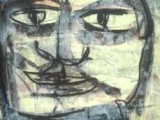Large Head Series
It seems weird to call something “Large Head Series”. But, it may be comprehensible if I say that it came about because of the Olmec sculpture I became aware of in Mexico. I haven’t had the opportunity to actually see the great work in and around San Lorenzo, near the Coatzacoalcos River, the Gulf Coast of Mexico. Furthermore, in the garden at our home in Mexico there is a reproduction of an Olmec head right square in the middle, and I see it every day as I go to my studio to paint.
Most of the research about the people that lived around this area about 1,000 years ago comes from the digs in the San Lorenzo and La Venta region in the Gulf Coast of Mexico. The distinctive Olmec art around 1150 BC features the striking were-jaguar – a creature combining both human and feline aspects. These huge heads made from basalt stone weigh many tons, some over 20 tons. Why, large heads? There are no written records to answer this question. But, some research has concluded that they are portraits, possibly monuments to individual rulers.
An agricultural population, the Olmecs, it is believed sought new resources; this brought them into contact with “widespread groups of peoples, particularly those in the neighboring highlands. For example, the strategically located center of Chalcatzingo traded with them, as did sites from the Valley of Mexico, Oaxaca, and the southern frontier of Mesoamerica. It seems clear that the exchange of goods and ideas that resulted from these contacts helped lead to the establishment of the Mexican civilization that flourished for nearly 3,000 years.” Source: The Cities of Ancient Mexico: Reconstructing a Lost World by Jeremy A. Sabloff.
Yet, in spite of the great importance of these peoples, no definitive reason for the large heads can be established, as there is no written record. The heyday of the Olmecs lasted only a few centuries. Their art will last forever, and the mystery of these large heads will probably never be solved.
 Salazar
Salazar

